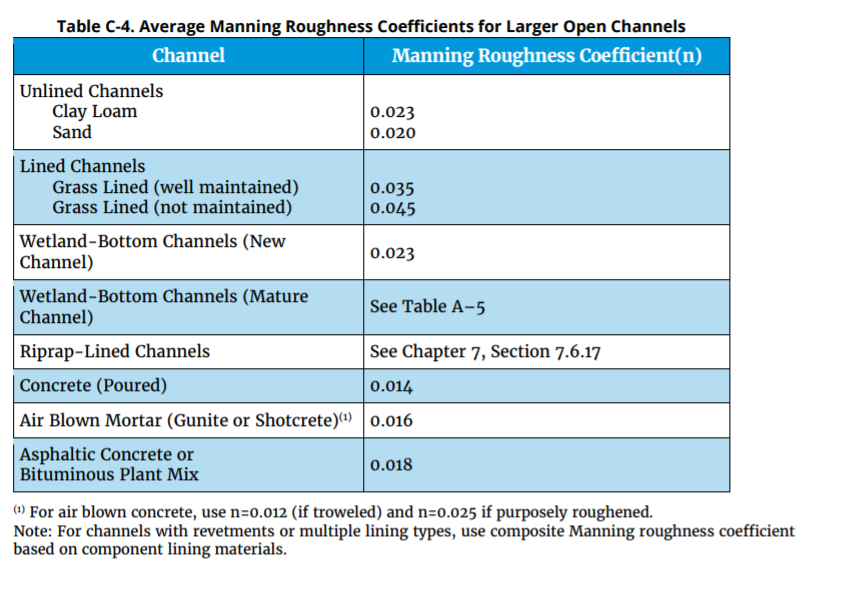a. A rectangular channel is 4 m wide and has a longitudinal slope of 0.002. The channel is poured concrete and it is discharging a uniform flow at 25 m3/s. What is the normal depth? Use Table C-4 for the roughness coefficient.
a. A rectangular channel is 4 m wide and has a longitudinal slope of 0.002. The channel is poured concrete and it is discharging a uniform flow at 25 m3/s. What is the normal depth? Use Table C-4 for the roughness coefficient.
Chapter2: Loads On Structures
Section: Chapter Questions
Problem 1P
Related questions
Question
Use Table C-4 for the following:
a. A rectangular channel is 4 m wide and has a longitudinal slope of 0.002. The channel is poured concrete and it is discharging a uniform flow at 25 m3/s. What is the normal depth? Use Table C-4 for the roughness coefficient.
b. A trapezoidal channel is designed for a uniform flow of 170 cfs. The channel has 8 ft bottom width and a side slope of 2 horizontal to 1 vertical. If the channel longitudinal slope is 0.001, what will be the normal depth? The channel material is asphaltic concrete. Use Table C-4 for the roughness coefficient.

Transcribed Image Text:Table C-4. Average Manning Roughness Coefficients for Larger Open Channels
Channel
Manning Roughness Coefficient(n)
Unlined Channels
Clay Loam
Sand
0.023
0.020
Lined Channels
Grass Lined (well maintained)
Grass Lined (not maintained)
0.035
0.045
Wetland-Bottom Channels (New
Channel)
0.023
|Wetland-Bottom Channels (Mature
Channel)
See Table A-5
Riprap-Lined Channels
See Chapter 7, Section 7.6.17
Concrete (Poured)
0.014
Air Blown Mortar (Gunite or Shotcrete)) 0.016
Asphaltic Concrete or
Bituminous Plant Mix
0.018
(1) For air blown concrete, use n=o.012 (if troweled) and n=0.025 if purposely roughened.
Note: For channels with revetments or multiple lining types, use composite Manning roughness coefficient
based on component lining materials.
Expert Solution
This question has been solved!
Explore an expertly crafted, step-by-step solution for a thorough understanding of key concepts.
This is a popular solution!
Trending now
This is a popular solution!
Step by step
Solved in 3 steps

Knowledge Booster
Learn more about
Need a deep-dive on the concept behind this application? Look no further. Learn more about this topic, civil-engineering and related others by exploring similar questions and additional content below.Recommended textbooks for you


Structural Analysis (10th Edition)
Civil Engineering
ISBN:
9780134610672
Author:
Russell C. Hibbeler
Publisher:
PEARSON

Principles of Foundation Engineering (MindTap Cou…
Civil Engineering
ISBN:
9781337705028
Author:
Braja M. Das, Nagaratnam Sivakugan
Publisher:
Cengage Learning


Structural Analysis (10th Edition)
Civil Engineering
ISBN:
9780134610672
Author:
Russell C. Hibbeler
Publisher:
PEARSON

Principles of Foundation Engineering (MindTap Cou…
Civil Engineering
ISBN:
9781337705028
Author:
Braja M. Das, Nagaratnam Sivakugan
Publisher:
Cengage Learning

Fundamentals of Structural Analysis
Civil Engineering
ISBN:
9780073398006
Author:
Kenneth M. Leet Emeritus, Chia-Ming Uang, Joel Lanning
Publisher:
McGraw-Hill Education


Traffic and Highway Engineering
Civil Engineering
ISBN:
9781305156241
Author:
Garber, Nicholas J.
Publisher:
Cengage Learning